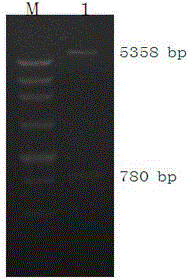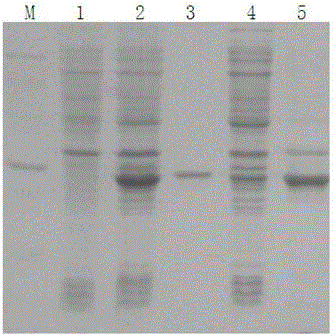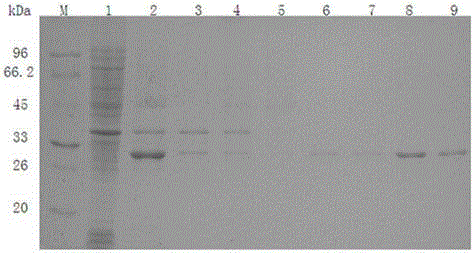Prokaryotic expression and application of lipase and immobilization method
A prokaryotic expression, lipase technology, applied in the field of enzyme engineering and molecular biology applications, can solve the problems of high cost, loss of enzyme activity, long time consumption, etc., to achieve improved stability and tolerance, wide substrate specificity, The effect of reducing steric hindrance
- Summary
- Abstract
- Description
- Claims
- Application Information
AI Technical Summary
Problems solved by technology
Method used
Image
Examples
Embodiment 1
[0053] Embodiment 1: Obtaining of lipase gene fragment
[0054] PCR primers were designed according to the gene sequence of Thermotoga maritima MSB8 lipase Tm1350 retrieved from NCBI (GenBank accession no. NP_229151.1) and the multiple cloning site (MCS) on the prokaryotic expression plasmid pET-28a. Using the biological software primer 5.0 to analyze the primers of the amplified lipase gene, design the upstream primer Tm1350-up and the downstream primer Tm1350-down,
[0055] Tm1350-up (BamHI): CGCGGATCCATGAGAATGAACATCCAGAAACACG,
[0056] Tm1350-down(XhoI): CCGCTCGAGTTATTTCCCTCCGAGTTTTTCGAGAC,
[0057] PCR reaction system (50 μL): PrimeSTAR® HS DNA Polymerase 0.5 μL, 5×PrimeSTAR Buffer 10 μL, dNTP Mixture 4 μL, Thermotoga maritima genome 0.5 μL, Tm350-up (10 μM) 1 μL, Tm350-down (10 μM) 1 μL, dd H2O33 μL. PCR program: 1) Pre-denaturation at 94°C for 3 min; 2) 30 cycles: 98°C for 10 s, 58°C for 10 s, 72°C for 1 min; 3) 72°C for 10 min.
[0058] PCR products were subjected...
Embodiment 2
[0059] Example 2: DNA recombination, expression and purification of lipase Tm1350 gene
[0060] (1) DNA recombination: restriction endonuclease Bam HI and xho I respectively digest the PCR product in Example 1 and the pET-28a (purchased from novagen) plasmid, then use T4 ligase to ligase the product, and transform the enzyme-ligated product connected overnight E. coli DH5α (purchased from GeneCopoeia) competent cells, select positive transformants for culture, extract the plasmid, and use double enzyme digestion and sequencing to determine that the lipase Tm1350 gene is correctly constructed into the expression vector, and the recombinant plasmid with successful sequencing is pET-28a -Tm1350.
[0061] figure 1 It is the agarose gel electrophoresis image of pET-28a-Tm1350 after double digestion, the size of pET-28a plasmid is 5358bp, and the size of Tm1350 gene fragment is 780 bp.
[0062] Transfer the successfully sequenced recombinant plasmids into E. coli BL2...
Embodiment 3
[0074] Embodiment 3: Refolding of recombinant protein
[0075] Cut the dialysis membrane into small pieces of appropriate length (15 cm), pay attention to wear gloves and do not touch the dialysis membrane directly; then put the dialysis membrane in 2% (w / v) NaHCO 3 Boil with 1mM EDTA (pH8.0) for 10min, wash the dialysis membrane thoroughly with distilled water, then put it into 1mM EDTA (pH8.0) and boil for 10min; after washing with distilled water, put the recombinant protein liquid purified and recovered above into dialysis Then put the dialysis membrane into different dialysis buffers one by one, and put it in the refrigerator at 4°C for 6 hours each time, and the urea concentrations were 8M, 4M, 2M, 1M, 0.5M, 0.25M, 0M , and finally dialyzed in saline / distilled water at 4°C for 6h; the dialyzed protein was aliquoted and stored at -70°C. The dialysis membrane was cleaned with distilled water, soaked in 50% glycerin, and stored in a refrigerator at 4°C.
PUM
 Login to View More
Login to View More Abstract
Description
Claims
Application Information
 Login to View More
Login to View More - R&D
- Intellectual Property
- Life Sciences
- Materials
- Tech Scout
- Unparalleled Data Quality
- Higher Quality Content
- 60% Fewer Hallucinations
Browse by: Latest US Patents, China's latest patents, Technical Efficacy Thesaurus, Application Domain, Technology Topic, Popular Technical Reports.
© 2025 PatSnap. All rights reserved.Legal|Privacy policy|Modern Slavery Act Transparency Statement|Sitemap|About US| Contact US: help@patsnap.com



